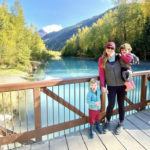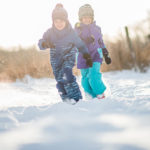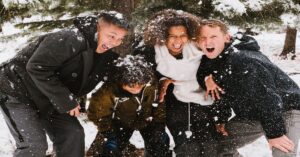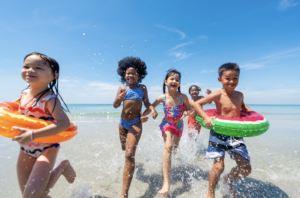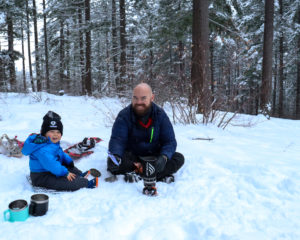No products in the cart.
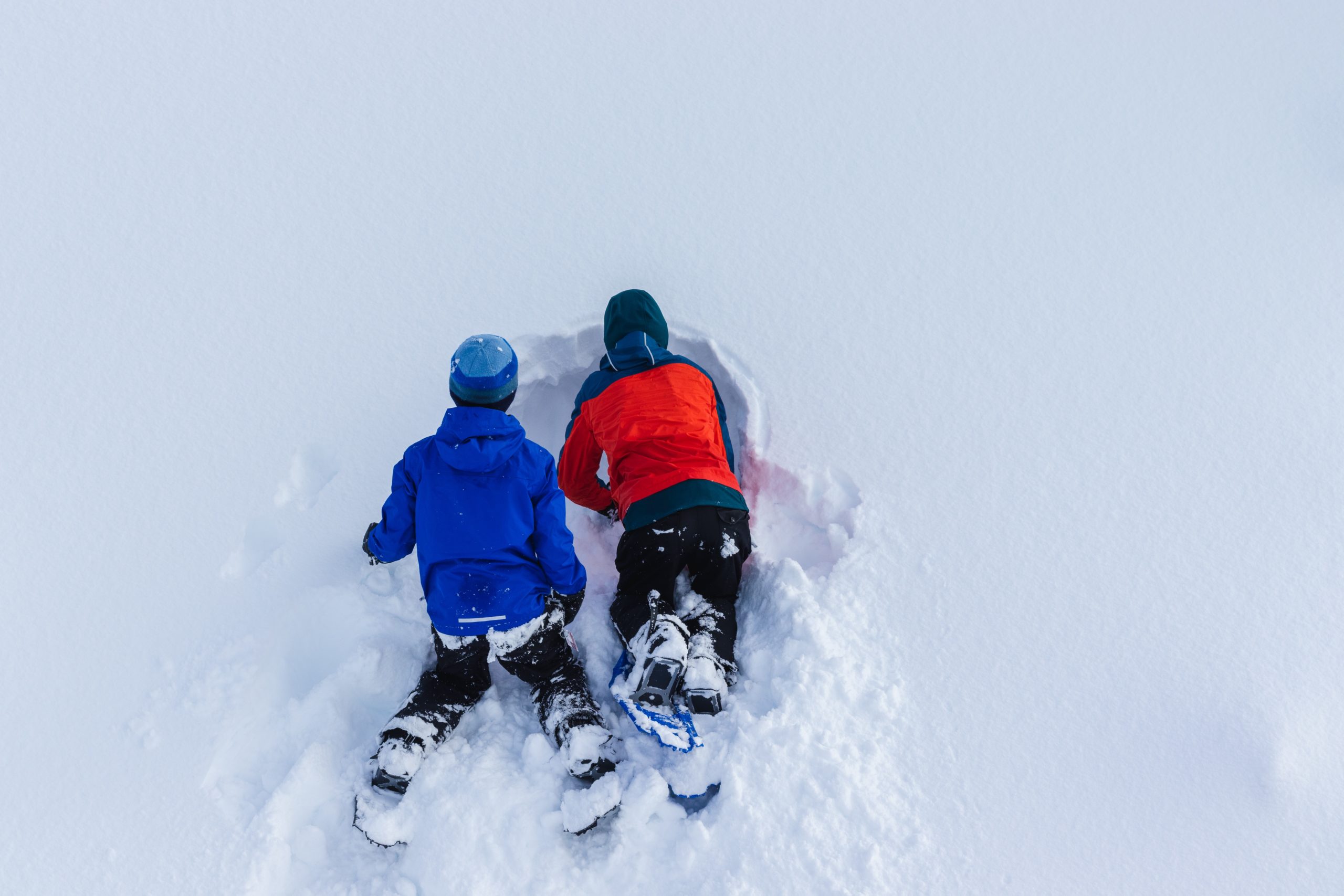
As cold weather makes it’s way, knowing how to dress your kids for the conditions is incredibly important. We’ve talked about layering a few times on our podcast — How To Dress Kid’s For Winter Adventures, Getting Outside in Winter and The Three Layer Winter Rule. Each episode is extremely helpful for all those wanting tips. You can click on each title to find where to listen to them!
This week’s blog post is a breakdown of these podcasts and much more!

A Breakdown Of The Three Layers:
- Base Layer: This is the layer in direct contact with your skin. Its main purpose is to transport or “wick” moisture off your skin and move it toward the surface of the fabric where it can evaporate. If your base layer holds moisture, you’ll quickly start to feel cold when you slow down or stop for a rest. Choose a thickness, or fabric weight, based on how cold it is and how active you expect to be. Look for seamless or flat-seamed garments that won’t rub against your skin when combined with outer layers or with a pack. And aim for a snug fit that isn’t constricting. We like merino wool (or wool). If the merino wool price point is not accessible, synthetic layers work too!
- Mid Layer: This layer adds insulation, traps body heat to keep you warm, and continues moving moisture outward. Materials that are fuzzy like fleece are a good choice because they insulate without feeling bulky. And they are highly air permeable so warm, moist air can easily pass through them. Gridded fleece and high-loft fleece trap warm air without adding bulk. Other mid-layer options are lightweight, low-profile insulated pieces – they can weigh less and compress nicely in your pack while still being warm. Mid-layers should be roomy enough to accommodate a base layer and allow movement, but should still be somewhat snug. We like fleece
- Top Layer: Your final layer, sometimes called a “shell,” protects you from the elements. Depending on the climate, you might want a layer that blocks wind, sheds precipitation or does both. It’s important that this layer is still breathable and allows the moisture from your inner layers to escape. Your outer layer should fit easily over your base and mid- layers, without being so loose that all your warmth escapes. And it should still allow you to move freely. We like water-resistant when they are younger, but waterproof once they are older and playing in the snow or rain
- Extra: Mitts, Toques/Beanies, Socks, Boots, Neck Warmer (fleece or merino wool – size differs between the two; merino wool is more snug)
Merino wool base layers are good for all seasons, because they keep you warm in the winter and cool in the summer [also acts as an SPF].
Natural Or Synthetic?
The type of fabric you choose will depend on climate, activity level, and desired amount of warmth. Certain fabrics, such as cotton are not ideal for layering as they retain wetness and can quickly make you feel chilled.
Synthetic base layers
Synthetic fabrics such as polyester and recycled polyester absorb very little water, so they are quick to dry. These fabrics have good stretch and are easy to care for. They make great base layers – except that they can retain odours if worn for multi-day trips. To combat that, many synthetic base layers have antimicrobial treatments to cut down on unwanted odours.
Wool base layers
A base layer made of merino wool can absorb up to 35% of its weight in moisture and remain dry to the touch since the moisture gets pulled inside the fibres. It has a soft texture and for the same weight, it will be warmer than synthetics. Wool is also naturally odour-resistant, so it’s a good choice if you’ll be working up a sweat day after day. Plus it’s highly breathable, great for temperature regulation, and is long lasting. The drawbacks with wool? It takes longer dry out, and it’s likely to be more expensive and less durable than synthetics. The bonus is that since it’s naturally antimicrobial, you don’t need to wash it as often.
Synthetic mid-layers
Polyester fleece is a classic insulating mid-layer. It traps warm air, it’s durable and absorbs very little moisture. Fleece can be a little bulky though. If space and weight are a concern, you might choose a gridded or high-loft fleece, or opt for a synthetic insulated piece that holds warmth while being compressible enough to carry in a very small pack.
Insulation materials
Down or synthetic insulated mid-layers are both good options if you’re looking for a combination of lightweight and warm. Down provides incredible warmth for weight, and can last a very long time if properly cared for. When wet, though, it loses much of its insulating value and is slow to dry. Synthetic insulators are typically less expensive than down and are easier to care for, but they are typically heavier and bulkier. They also dry out quickly and keep much of their original insulating value when they’re wet.
Additional Tips
Babies
- Check baby’s temperatures by feeling the temperature on the back of their neck
- When babywearing, B&Me (https://bookerandme.com) or babywearing specific layers help to keep both baby and caregiver warm
Toddlers
- When getting to potty training/toilet learning stage, 2-piece clothing is easier than 1-piece
Older Kids
- Set out the layers in order, so they can get themselves dressed
The stage when kids don’t want layers on:
- Try singing (even about what you’re doing)
- Use a whisper
- Keep your energy calm
Always pack extra clothes, in case anything gets wet.
-10 to -15 degrees Celcius is our limit for big adventures. Colder than that, short adventures just in the backyard.
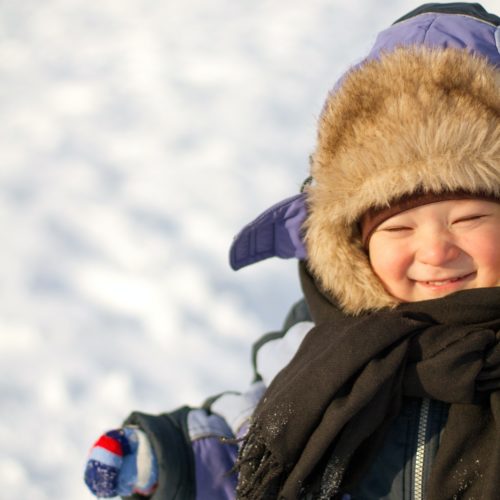
Frost Bite
- This affects cheeks, fingers, toes, ears, and noses when they are not properly covered. The skin freezes and you see it red and swollen. Kids will feel a stinging and burning sensation.
- Frostbite can be caused by cold wind, rain, or snow. If it is not addressed immediately, the skin can turn, grey, pale and blistered.
- If your child complains of numbness or pain in their hands, feet or elsewhere, begin to warm that area with your hands, but be careful not to rub the skin if it is frostbitten. Get the child indoors.
- Use warm (not hot) washcloths or water to slowly warm the skin. Dry the areas where you applied the washcloths and give your child a warm drink.
- Call your doctor for treatment if the numbness lasts for more than a few minutes.
Hypothermia
- This can happen if your child is outside for a long time and gets wet. A child can get hypothermia even in warmer weather, like 10°C, especially if it is rainy and windy.
- Hypothermia can set in when your child’s body temperature drops below the normal 37°C (98.6°F). The child can shiver badly, slur their speech or become clumsy.
- When this happens, call 911. You should get your child indoors and remove any wet clothing.
- Wrap the child in warm blankets.
Some of our favourite pieces and stores
- Iksplor Merino Wool Thermal Base Layers
- Patagonia Elements — Patagonia has a fleece bunting and you can click here to find yours!
- SimplyMerino Base Layers
- KOJO Activewear — perfect for breastfeeding Moms!
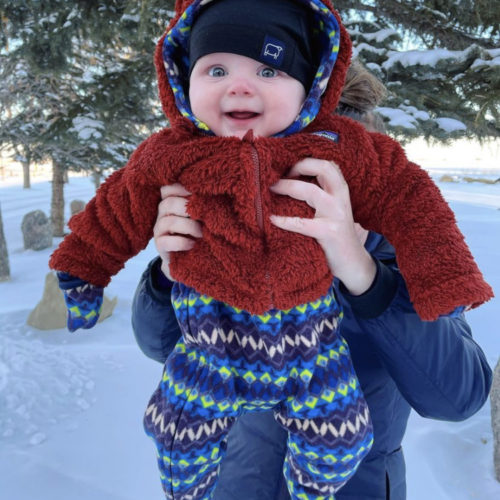
Thank-you for following along with this week’s blog post! Happy Exploring.
Make sure to tag us in your Instagram posts and use hashtags #KidsWhoExplore and #KWE for your chance to be featured on our page! We can’t wait to follow along with your next adventure.
